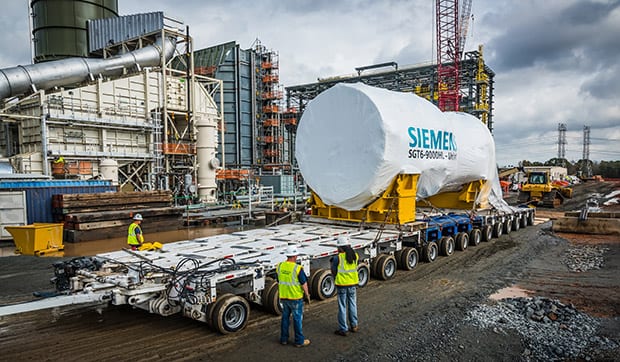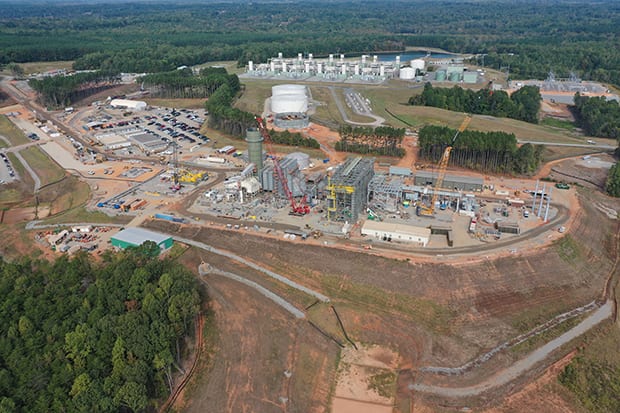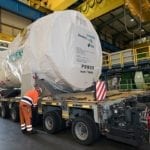Siemens has delivered its first-ever HL-class gas turbine to Duke Energy’s Lincoln County Combustion Turbine generation station, located near Denver, North Carolina.
The HL-class gas turbine was derived from proven Siemens H-class technology in what the company calls “an evolutionary development step.” The advanced air-cooled gas turbine is a next-generation design that uses a series of new, but already tested technologies, such as “super-efficient internal cooling features for blades or vanes and an advanced combustion system to increase firing temperature,” Siemens said.
The Siemens HL-class consists of three engines: SGT5-8000HL, SGT5-9000HL, and SGT6-9000HL. In a combined cycle configuration, efficiency of the units is expected to exceed 63%, with gross capacities of about 481 MW, 593 MW, and 405 MW, respectively. Duke Energy received the SGT6-9000HL (Figure 1).
 |
| 1. A heavy-hauler was used to deliver the Siemens HL-class gas turbine to the Lincoln County site in North Carolina. Courtesy: Duke Energy |
To validate the new HL technology, it first underwent component and prototype testing at Siemens’ facilities in Germany. This month, workers lifted the 340-ton turbine onto its foundation at the Lincoln County site (Figure 2). The new unit is expected to start operating in early 2020. It will operate in simple-cycle mode during a four-year testing process at the Duke Energy station.
 |
| 2. An overhead crane was used to place the gas turbine onto its permanent foundation. Courtesy: Duke Energy |
“This turbine will help Duke Energy by providing a flexible energy source to support our renewable program—solar—as well as provide power for 300,000 homes in this area,” Gary Thompson, project director with Duke Energy, said in a video released by the company. “It also is good for Duke to be involved in first-of-a-kind projects and new technology. This unit is going to be 34% more efficient than any other unit we have on our system.”
“For Duke, this is going to be a great addition to their fleet. It’s a highly efficient engine. It’s a fast-start engine. It’s going to help balance the flux that we have in the market today with renewables, and also supports the Siemens strategy of making fossil greener by being a very highly efficient engine—best in class,” Brian Daly, executive vice president Solutions Americas with Siemens, said in the video.
“The gas turbine’s been in development for many years,” Daly said. “It took a lot of people—a lot of great minds, a lot of inspiration—to get us to where we are today. I think this is something that Siemens really values, and we’ve put a lot of effort into having the right people onboard. First of all, in the gas turbine development itself, all of the auxiliaries that go around it, and the construction.”
Duke Energy and Siemens entered into the agreement for the Lincoln County expansion (Figure 3) in June 2017. The 746-acre site is home to 16 previously installed natural gas-fueled, simple-cycle combustion turbines, with a total capacity of 1,200 MW. Those units have been in service since 1995.
When the project was announced, David Fountain, Duke Energy’s North Carolina president at the time, said, “This unique arrangement with Siemens offers a significant cost savings to our customers while providing one of the most advanced, efficient gas turbine units in the U.S.” Duke Energy will receive power from the plant during the four-year testing period, while only paying for a portion of the fuel costs. Once testing is completed in 2024, the company will begin operating the unit.
Siemens has secured at least two additional orders for the HL-class gas turbine. In June 2018, the company said it would collaborate with Scottish energy company SSE to build the Keadby 2 power station in Lincolnshire, England. That will be the first deployment of the 50-Hz version of the SGT-9000HL. Siemens has also signed a deal with Cooperative Energy, a member-owned not-for-profit utility headquartered in Hattiesburg, Mississippi. Cooperative Energy will re-power its coal-fired R.D. Morrow Sr. Generating Station in Purvis, Mississippi, with HL gas turbine technology.
—Aaron Larson is POWER’s executive editor (@AaronL_Power, @POWERmagazine).










